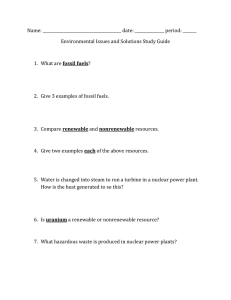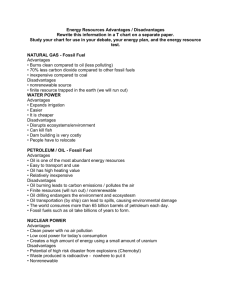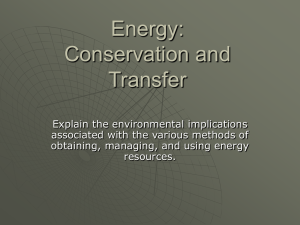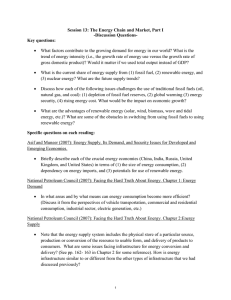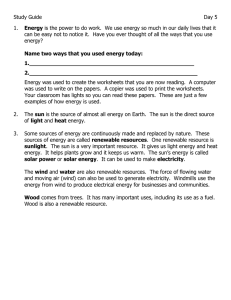Energy Sources
advertisement
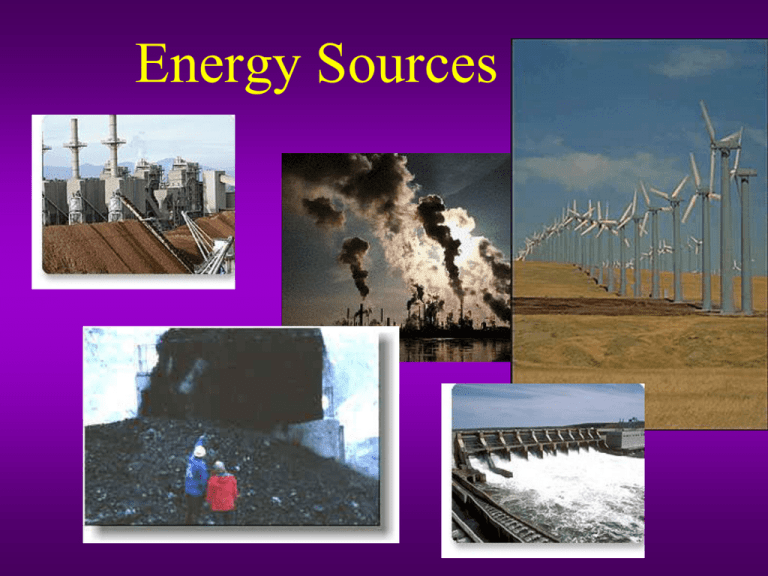
Energy Sources What is the difference between renewable and nonrenewable energy resource? • A nonrenewable resource is a natural resource that cannot be re-made or regrown at a scale comparable to the rate at which it is used. • Renewable resources are natural resources that can be replenished in a short period of time. Fossil Fuels: Nonrenewable Coal, Oil and Natural Gas are called "fossil fuels” because they have been formed from the fossilized remains of prehistoric plants and animals. They provide around 66% of the world's electrical power, and 95% of the world's total energy demands Advantages of Using Fossil Fuels • Very large amounts of electricity can be generated cheaply • Transporting it is easy • Very efficient • Power stations that use fossil fuels can be built anywhere Disadvantages of Using Fossil Fuels • Produces carbon dioxide when burned, which contributes to global warming • Burning coal produces sulfur dioxide, causes acid rain • Oil spills • Mining coal is difficult, dangerous, and harms the land Nuclear Power: Nonrenewable • Nuclear power is generated using Uranium, which is a metal mined in various parts of the world. • Nuclear power produces around 11% of the world's energy needs, and produces huge amounts of energy from small amounts of fuel, without the pollution that you'd get from burning fossil fuels. Advantages to Using Nuclear Power • Fairly cheap • Does not produce carbon dioxide or sulfur dioxide, so it doesn’t contribute to global warming or acid rain • Produces huge amounts of energy from small amounts of fuel • Produces small amounts of waste Disadvantages of Nuclear Power • Although not much waste is produced, the waste is very, very dangerous. Solar Power: Renewable – – Solar Cells really called “photovoltaic" or "photoelectric" cells) convert light directly into electricity. • In a sunny climate, you can get enough power to run a 100W light bulb from just one square meter of solar panel. Advantages to Solar Power • Free • Does not produce pollution • Can be used in remote locations Disadvantages to Solar Power • Doesn't work at night • Very expensive to build solar power stations • Power stations take up lots of space/land • Unreliable unless you're in a very sunny climate Wind Power: Renewable • The Babylonians and Chinese were using wind power to pump water for irrigating crops 4,000 years ago, and sailing boats were around long before that. • Wind power was used in the Middle Ages, in Europe, to grind corn, which is where the term "windmill" comes from. Advantages to Wind power • • • • Wind is free Needs no fuel to be produced Produces no waste or pollution The land beneath windmills can usually still be used for farming • Can be used in remote areas Disadvantages of Wind Power • Unreliable • Can be expensive depending upon land cost • Can kill birds • Affects television reception nearby • Noisy Hydroelectricity : Renewable • A dam is built to trap water, usually in a valley where there is an existing lake. • Water is allowed to flow through tunnels in the dam, to turn turbines and thus drive generators. • Hydro-electricity provides 20% of the world’s power • This is how we get our electricity. Advantages of Hydroelectricity • • • • • • Free except for cost of dam No waste or pollution Much more reliable than wind, solar or wave power Water is stored behind dam for use Electricity can be generated constantly, unlike other renewable resources Disadvantages to Hydro-electricity • • Dams are very expensive to build • Building dams floods areas upstream, affects wildlife • Finding a suitable site can be difficult • Water quality and quantity downstream can be affected, affects wildlife Biomass- Renewable • Biomass includes plant and animal wastes, trees, other living material. • Plant and animal waste is used to produce fuels such as methanol, natural gas, and oil. We can use rubbish, animal manure, woodchips, seaweed, corn stalks and other wastes. Sugar cane is harvested and taken to a mill, where it is crushed to extract the juice. The juice is used to make sugar, whilst the left-over pulp, called "bagasse" can be burned in a power station. Other solid wastes, can be burned to provide heat, or used to make steam for a power station. Advantages to Biomass • Recycles waste that would just be thrown away • Cheap • Less demand on the Earth's resources Disadvantages to Using Biomass • Collecting the waste can be difficult • Must be burned, so generates pollution (carbon dioxide-global warming- and sulfur dioxide-acid rain) • Using trees cuts down on forests and contributes to global warming Geothermal Power: Renewable – Hot rocks underground heat water to produce steam. We drill holes down to the hot region, steam comes up, is purified and used to drive turbines, which drive electric generators. Advantages to Geothermal Power • No pollution, does not contribute to global warming or acid rain • Not much impact on environment • No fuel is needed • Very cheap, once holes are drilled Disadvantages to Geothermal Power • Not many suitable sites because hot rocks are needed and type of rock must be easily drilled through. • Site may "run out of steam” • Hazardous gases and minerals may come from underground, and can be difficult to safely dispose of Tidal Power: Renewable • Works like hydro-electric but dam is much bigger. • A huge dam (called a "barrage") is built across a river estuary. When the tide goes in and out, the water flows through tunnels in the dam. • The ebb and flow of the tides can be used to turn a turbine, or it can be used to push air through a pipe, which then turns a turbine. Large lock gates, like the ones used on canals, allow ships to pass. • Only around 20 sites in the world have been identified as possible tidal power stations. Advantages to Tidal Power • • • • Free once barrage is built It produces no pollution It needs no fuel Reliable and predictable (because tides are predictable) Disadvantages to Tidal Power • Barrage is very expensive to build • Barrage affects the environment for many miles upstream and downstream • Few suitable sites for tidal barrages • Only provides power for around 10 hours each day, when the tide is actually moving in or out. sources • http://www.darvill.clara.net/altenerg/fossil.h tm • http://www.umich.edu/~gs265/society/fossil fuels.htm
